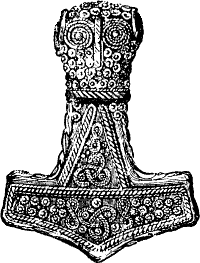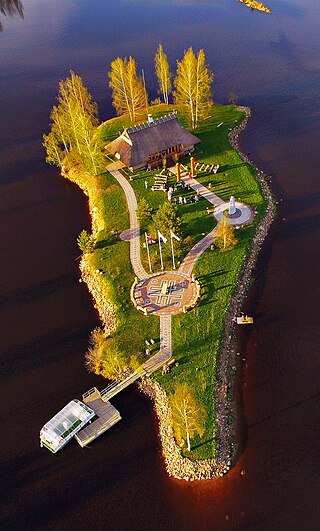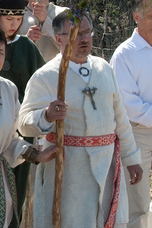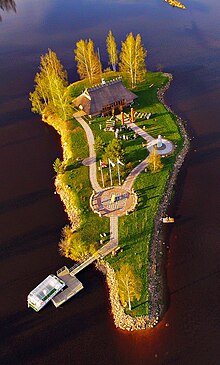
Heathenry is a modern Pagan new religious movement that has been active in the United States since at least the early 1970s. Although the term "Heathenry" is often employed to cover the entire religious movement, different Heathen groups within the United States often prefer the term "Ásatrú" or "Odinism" as self-designations.

Modern paganism, also known as contemporary paganism and neopaganism, is a type of religion or family of religions influenced by the various historical pre-Christian beliefs of pre-modern peoples in Europe and adjacent areas of North Africa and the Near East. Although they share similarities, contemporary pagan movements are diverse and as a result, they do not share a single set of beliefs, practices, or texts. Scholars of religion often characterise these traditions as new religious movements. Some academics who study the phenomenon treat it as a movement that is divided into different religions while others characterize it as a single religion of which different pagan faiths are denominations.

Dievturība is a modern continuation of the ethnic religion of the Latvians from what it was before Christianization in the 13th century. Adherents call themselves Dievturi, literally "Dievs' keepers", "people who live in harmony with Dievs". The movement is mainly based on Latvian folklore, folk songs and Latvian mythology.

Romuva is a neo-pagan movement derived from the traditional mythology of the Lithuanians, attempting to reconstruct the religious rituals of the Lithuanians before their Christianization in 1387. Practitioners of Romuva claim to continue Baltic pagan traditions which survived in folklore, customs and superstition. Romuva is a polytheistic pagan faith which asserts the sanctity of nature and ancestor worship. Practicing the Romuva faith is seen by many adherents as a form of cultural pride, along with celebrating traditional forms of art, retelling Baltic folklore, practicing traditional holidays, playing traditional Baltic music, singing traditional dainos (songs), as well as ecological activism and stewarding sacred places.
Baltic mythology is the body of mythology of the Baltic people stemming from Baltic paganism and continuing after Christianization and into Baltic folklore.

European Congress of Ethnic Religions (ECER) is an organisation for cooperation among associations that promote the ethnic religions of Europe. The primary goal of the ECER is the strengthening of pre-Christian religious traditions of Europe, emphasizing and fostering their ties with modern pagan movements.

Kūlgrinda is a folk music group from Vilnius, Lithuania, established in 1989 by Inija and Jonas Trinkūnas. The group is connected to the Lithuanian neopagan movement Romuva and often performs as a part of the movement's ceremonies.

Modern Paganism in World Cultures: Comparative Perspectives is an academic anthology edited by the American religious studies scholar Michael F. Strmiska which was published by ABC-CLIO in 2005. Containing eight separate papers produced by various scholars working in the field of Pagan studies, the book examines different forms of contemporary Paganism as practiced in Europe and North America. Modern Paganism in World Cultures was published as a part of ABC-CLIO's series of books entitled 'Religion in Contemporary Cultures', in which other volumes were dedicated to religious movements like Buddhism and Islam.

Pagan Theology: Paganism as a World Religion is a taxonomical study of various world religions which argues for a new definition of the word "paganism". It was written by American religious studies scholar Michael York of Bath Spa University and first published by New York University Press in 2003.
Uralic neopaganism encompasses contemporary movements which have been reviving or revitalising the ethnic religions of the various peoples who speak Uralic languages. The movement has taken place since the 1980s and 1990s, after the collapse of the Soviet Union and alongside the ethnonational and cultural reawakening of the Finnic peoples of Russia, the Estonians and the Finns. In fact, Neopagan movements in Finland and Estonia have much older roots, dating from the early 20th century.
Eclectic paganism, also occasionally termed universalist or non-denominational paganism, is a form of modern paganism where practitioners blend paganism with aspects of other religions or philosophies, including the blending of separate pagan traditions. In the book Handbook of New Age, Melissa Harrington states that "Eclectic Pagans do not follow any particular Paganism, but follow a Pagan religious path, that includes the overall Pagan ethos of reverence for the ancient Gods, participation in a magical world view, stewardship and caring for the Earth, and 'nature religion.'" The practice of eclectic paganism is particularly popular with pagans in North America and the British Isles.

Lokstene Shrine of Dievturi is a Dievturi religious building in Aizkraukle Municipality, in the Vidzeme region of Latvia. It was inaugurated in 2017 and is used by the organization Latvijas Dievturu sadraudze for devotional ceremonies and annual celebrations.

Ernests Brastiņš was a Latvian artist, amateur historian, folklorist and archaeologist. He is known as the founder and driving force behind the neopagan religion Dievturība, which he started in the 1920s and which was re-established after the fall of the Soviet Union.
Jēkabs Bīne was a Latvian painter, stained glass artist, teacher and art critic.

Modern pagan music or neopagan music is music created for or influenced by modern Paganism. Music produced in the interwar period include efforts from the Latvian Dievturība movement and the Norwegian composer Geirr Tveitt. The counterculture of the 1960s established British folk revival and world music as influences for American neopagan music. Second-wave feminism created women's music which includes influences from feminist versions of neopaganism. The United States also produced Moondog, a Norse neopagan street musician and composer. The postwar neopagan organisations Ásatrúarfélagið in Iceland and Romuva in Lithuania have been led by musicians.
Kriwe Kriwaito or simply Kriwe was the chief priest in the old Baltic religion. Known primarily from the dubious 16th-century writings of Simon Grunau, the concept of kriwe became popular during the times of romantic nationalism. However, lack of reliable written evidence has led some researchers to question whether such pagan priest actually existed. The title was adopted by Romuva, the neo-pagan movement in Lithuania, when Jonas Trinkūnas was officially installed as krivių krivaitis in October 2002.

Jonas Vaiškūnas is a Lithuanian ethnoastronomer, religious leader, publisher and politician. He is the head of the department of ethnography at the Museum of Molėtai and priest in the Baltic neopagan organisation Romuva.
Arvīds Brastiņš was a Latvian sculptor, writer and neopagan leader. He was educated at the Saint Petersburg Stieglitz State Academy of Art and Design and began to exhibit his folklore-inspired sculptures in 1918. He worked as a schoolteacher and was active as a writer, writing about Latvian folklore and publishing collections of folksongs. Brastiņš was the brother of Ernests Brastiņš who founded the Baltic neopagan movement Dievturība in the 1920s. Both brothers became major intellectual leaders within this movement. Resettled in the United States after the Soviet occupation of Latvia, Arvīds Brastiņš led an émigré continuation of the movement until his death.
Modern paganism, also known as contemporary paganism and neopaganism, is a collective term for new religious movements which are influenced by or derived from the various historical pagan beliefs of pre-modern peoples. Although they share similarities, contemporary pagan religious movements are diverse, and as a result, they do not share a single set of beliefs, practices, or texts.













